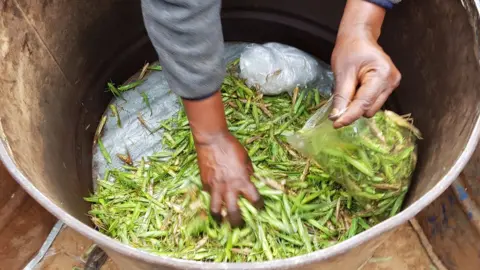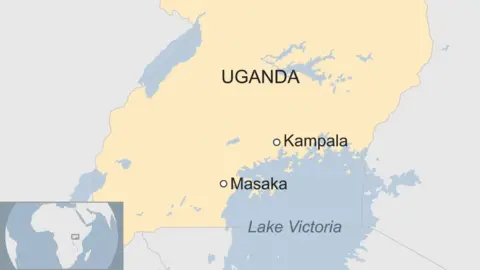The Ugandan love of grasshoppers - and how to harvest them
 BBC
BBCIt is grasshopper season in Uganda, where they are seen as a nutritious delicacy - either boiled or deep-fried. They are so popular that some are worried about declining harvests, as the BBC's Patience Atuhaire reports.
It is dusk. Rusty oil barrels are lined up in rows. Wooden scaffolding holds up unpainted iron sheets. The blindingly bright lights are rigged up as if for a sports stadium. But the four young men are not preparing to play football, they are here to catch grasshoppers.
At this time of year, during the rainy season, the scene is repeated in many towns across the country.
"When the season starts, we watch the cycle of the moon, and prepare. [They tend to come out at full moon]. We also keep hoping for rain. The larger numbers appear when it has rained," says Quraish Katongole, one of Uganda's most experienced grasshopper trappers.

He is the chairman of a group that coordinates the grasshopper trade around the country.
As his workers set up the last of the barrels at a trapping site here on the edge of Masaka town, he heads off to supervise work at other locations.
Salty, crunchy flavour
As it grows darker, the slim-bodied nocturnal insects start to swarm around the lights. Most of them are green, but there are sprinklings of ashy-brown and golden-brown.
The trappers burn fresh grass and the rising smoke makes the insects dizzy. The grasshoppers smash against the iron sheets, falling straight into the drums. It sounds like fat raindrops on a tin roof. And as the numbers increase, it becomes a steady downpour.
Women, schoolgirls still in their uniforms, even children, scour the bushes surrounding the traps, picking up the escapees that have avoided the barrels, before they can burrow further into the greenery.

The edible insects are a delicacy in many Ugandan communities, and for the urban population, a sought-after snack.
During rush hour in the capital, Kampala, young people with baskets or plastic buckets, weave through the traffic selling boiled or deep fried ready-to-eat grasshoppers to commuters. A tablespoonful costs 1,000 Uganda shillings ($0.27, £0.21).
Others sell fresh green ones, with the wings and legs already plucked off, that can be prepared at home.
Even though most Ugandans love the grasshoppers, I last tasted them as a child, so I vaguely remember the crunchy, salty flavour.
But the idea of popping a roasted insect into my mouth has never appealed to my grown-up taste-buds.
'Eat more insects'
Ugandans, and others in the region, are among over two billion people worldwide who eat different species of insects, according to a UN estimate.
A 2013 UN Food and Agriculture Organization report urged others who were not already munching insects to consider adding them to their diet, saying that this could boost nutrition and the amount of food available.
But in Uganda, the number of grasshoppers could be falling as their feeding and breeding habitats around Lake Victoria are shrinking.
Every year between 2010 and 2015 the country lost over 46,000 hectares (114,000 acres) of its natural forest cover, according to the National Forest Authority.
In the greater Masaka area, which is the traditional hub of the grasshopper industry, 9,000 hectares of wild habitat were converted into farmland or for settlement use between 1990 and 2005.
Nearby, on the road towards Bukakata Port on the shores of Lake Victoria, large trees have been felled in a forest reserve. Large swathes of what was formerly forest and grassland are now pineapple plantations.

Mr Katongole has witnessed this transformation.
"There was a huge natural forest and swamps in this area, and in the islands; they were all cut down. That resulted in the numbers of grasshoppers appearing in this region each season declining," he says.
Speaking from 30 years' experience in the trade, he adds: "You'd hear people say; 'I am going to Masaka, that is where there are grasshoppers', but that has changed."
And the evidence from the night's work backs that up.
The young men empty the drums pouring their catch into white sacks. For all that frenzied swarming, they manage to fill just two sacks.
Grasshopper transport
"There was a time when I would catch 20 to 25 sacks a night," Mr Katongole comments, crestfallen.
At about 05:00 local time (02:00 GMT), he loads up a saloon car with sacks collected from around town and a colleague makes the three-hour drive to Kampala, where each sack can fetch at least $80 (£63).
But the demand for grasshoppers is not only in the capital.
The morning brings a whirlwind of activity in the main market on the outskirts of Masaka. To attract buyers, vendors call out prices, while some adopt a musical approach by singing and clapping their hands.

Some sell out of barrels, while others use large plastic buckets or trays. Grasshoppers in all forms are on display; sellers measure out cupfuls or handfuls of fresh ones into plastic bags.
Saucepans of boiling insects sit on charcoal stoves.
Agnes Nansamba is smiling as she cooks. A smaller harvest means more customers for her. She lifts a pan and shakes it, turning the grasshoppers over.
'God-given' treat
"We used to sell here all day and you would not get enough customers. But today, I've boiled just 12 cupfuls. I will sell each at 5,000 Uganda shillings ($1.35). A few weeks ago, the price was [even] higher," she says.
As we speak, a truck with sacks hanging from metal railings pulls up. Many of the traders run over to replenish their stock.
In the melee, no-one gives a thought as to where the insects appear from. They just know that they come in May and November, when the rains fall. They see them as a gift from God.

But a group of Ugandan scientists are trying to understand more about their life cycle to see if they can be harvested in a more sustainable way.
Prof Phillip Nyeko, the lead researcher, says that apart from loss of habitat, aggressive harvesting presents another threat.
"They do not swarm to be eaten, they swarm to feed and breed. But when you put up lights and collect them in the thousands, you're upsetting their life cycle.
"You don't know if you're picking egg-laying ones, male or female. So don't be surprised if there are fewer the next season."

More from Patience Atuhaire:

Artificial breeding
His team is researching the possibility of breeding and rearing grasshoppers in a controlled way to make them available all year round.
"We are trying to develop procedures or protocols on how you can mass-rear these insects. Developing the feeds that are nutritious, and the feeds that produce the insects that we want in terms of their quality, in terms of their taste," he explains.
Prof Nyeko says his team will experiment with mass breeding at the end of next year.
If they succeed, Ugandans will be happy to know that they can continue to enjoy a grasshopper snack and not only during the rainy season.
